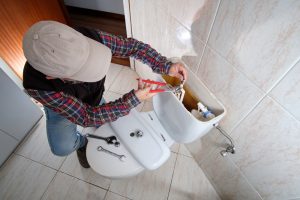
Every year there are thousands of water leaks that go undetected. This can lead to hundreds of dollars in wasted water and damage to your property from mould, mildew, or rot.
Water leak detection is a necessary step in protecting your home from the potential dangers of unseen water leaks. If you’re unsure of how to detect water leaks in your home, feel free to continue reading our article below as we discuss some steps you can take for water leak detection.
The Importance Of Water Leak Detection
Water leaks can happen for a variety of reasons. They might be as small and contained as the drip from your faucet, or they could cause flooding in an entire building. However, while water leaks may seem harmless at first, these small changes could be indicative of much larger issues. If these issues are left untouched they will eventually cause major structural damage which cost exponentially more money to fix than prevention would have been.
With that, some steps you can take to check for water leaks include the following down below:
1). Check Your Water Meter
Water leaks can be a sneaky and expensive problem to deal with. However, water meters can show if you’re using more water than usual. This is an easy way of detecting leaks without having to resort to other means which might cost more money than just getting it fixed right away! If your water meter reflects a really high or unusual reading then there might just be an issue with leaks in your pipes or faucets.

2). Check Your Appliances And Fixtures
If your water meter has reflected unusually high readings, then it’s best to check your appliances and fixtures for signs of leaks. Check the cabinets under the sinks in your bathroom, kitchen, or laundry. You can also check for small pools of water around your bathtub, shower, washing machine, and other appliances that use water.
3). Look For Wet Spots On The Floor, Walls, Or Ceiling
An easy way to check for a water leak is by looking out for wet areas on the walls, floors, or ceiling. You might even find signs of mould growth in damp areas which can be a sign that a leak has been occurring in that area for a while. Bubbling or bulging wallpapers, musty smells, and discolouration on your walls are also other side effects of leaks in your floor, walls, or ceilings. These are all indicators that there could be an issue with your plumbing.
4). Listen For Dripping Sounds In Your Home
Many people don’t know that the first sign of a leak is often hearing it. If it’s not immediately clear where the leaking sound is coming from, try following the sound to their source and checking all potential sources in that area. Chances are there is at least one leak around the area.
5). Try The Colour Dye Trick
Toilets are some of the most susceptible fixtures to water leaks commonly caused by a brittle toilet flapper. A quick and easy way to see if you have a leak is by dyeing your toilet bowl blue with food colouring in order to detect any potential problems. All you need are four drops of food colouring in the toilet tank, then wait for at least five minutes. If you do have a water leak, then the colour should have seeped into the bowl.

6). Call A Professional Plumber
Water leaks can cause all kinds of damage to your property and leave you with high water bills that could have been avoided if detected early enough. Call a professional plumber as soon as possible, so they can come out, diagnose the problem and fix it before more costly damages happen, saving you money in repairs in the long run!
Summary
The steps in leak detection are critical to know because not only will it help you find the source of a water leak, but also help prevent further damage. Luckily, there are many different ways to protect your home from water leaks in the future. However, it is always best to call a professional plumbing service to help get your water leak fixed safely and properly.
If you suspect you have a water leak, please call us at Water Leak Detection for a free consultation today on 1300 425 325 or leave an inquiry on our website.

